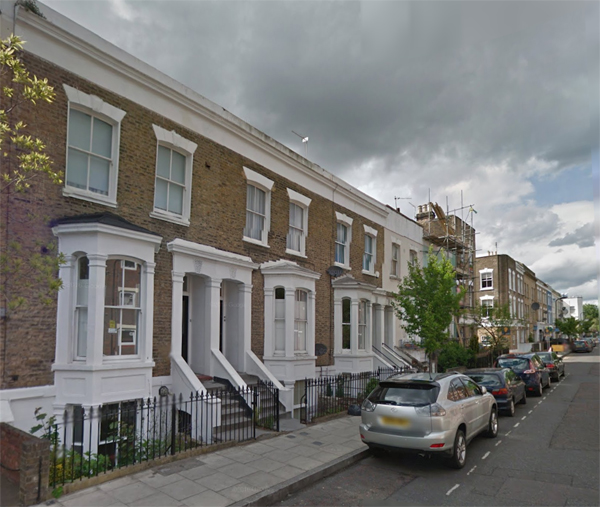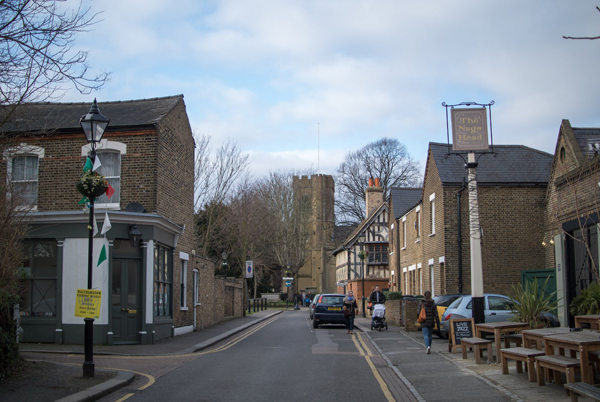Like many 20-something Londoners, the idea of owning my own place had always seemed so wildly unlikely that I didn’t bother worrying about it. I had taken it as a given that my monthly rent and bills for a London flatshare would absorb around half of my monthly wage.
That is until last summer, when my boyfriend Jonny and I bought 40% of a two-bedroom flat in Clapton, Hackney, for £146,000 through the Share to Buy scheme, with a deposit of just over 5% of the overall value.
So how did we do it?
Three years ago, we first moved in together, into a flat in Stoke Newington, Zone 2, On The Road below.
But renting a one-bed worked out more expensive than we thought.
Once bills were factored in, we were actually paying more than when we were renting rooms separately. We adored the place, but in reality we ended up splashing out for a damp-infested basement.
Our letting agency had refused to address some epic mould issues, and we felt stuck. Still, despite the amount we were coughing up each month, our rent was considered reasonable for the area. So, if we were to move, we faced additional “admin fees,” and probably even higher rent.
The out-of-reach property ladder

The first flat we rented in Stoke Newington
We Had Some Money For A Deposit And Started Looking Into Buying A Place. But we soon learned that what we had would get us nowhere on the open market in any of the areas we wanted to live in.
Moving in together was a grown up enough step in and of itself, and we weren’t ready to move to the outer suburbs with a monster commute — a reasonable request in most other European, even UK cities.
Stoke Newington was well out of the picture in terms of house prices, so we went to speak to an estate agent in Walthamstow (Zone 3). At the time, everyone seemed to be talking about the “up-and-coming area,” so it seemed like a good compromise. The leafy Walthamstow Village, shown below, is particularly popular among younger buyers.
But we were too late. The Walthamstow property market was already booming, and at that time we would have needed at least a 20% deposit (£50,000) to be taken seriously for a one-bed flat, for which prices were starting at about £250,000. We had less than half of that deposit.
We were told many of the flats were being snapped up by property developers, who were blowing buyers out of the water with offers of 100% equity at bidding stage — or, just gazumping them later down the line.
Whether there was an element of scare-mongering from the agents we spoke to or not, it felt depressing, and wholly unattainable.
Discovering Share to Buy
Defeated, we resorted back to the damp flat. Our only other options were to sign for another year with our hopeless agent, or worse — move back into a flatshare to reduce our outgoings in order to try and save.
One night at the pub we got talking to a friend who had bought a shared ownership property a few years before. It sounded too good to be true — a scheme that allows you to buy part of a property in an area where you otherwise wouldn’t be able to afford a bedsit.
How had we not heard of this?
We had heard of the Help to Buy scheme, which was great for helping first time buyers scrape together more of a deposit, but with greater lending restrictions following the 2008 crisis, it wouldn’t have helped people like us.
Even taking into account both of our salaries, we were unlikely to be approved enough of a mortgage for a one-bed.
Shared ownership, on the other hand, offers people who can’t quite afford a mortgage on 100% of a home to buy stakes of between 25% and 75% of a home’s value and pay rent on the remaining share, as well as a service charge. You can buy more of the property later — which is known as “staircasing.”
The scheme has been around for decades, first known as “Part Buy and Part Rent,” but has been rebranded over the years, and is now most commonly referred to as “Share to Buy.”
Tariq Qureshi, a sales manager at housing association Southern Housing, told me: “It was initially targeted at people in social housing, who fell in the gap of earning enough not enough to rent from local authorities but not enough to buy outright.”
“But over the years, as property prices have continued to grow, the market has opened up to a wider and more diverse audience who is unable to buy outright on the open market.”
We represented that new demographic.
Figuring out the financials

Walthamstow Village, which was out of our reach.
The Share to Buy website became the fixation of our lives for the next seven months.
The first thing we found was that, just like on the open market, there were new builds up for sale, as well as second-hand homes, known in the shared ownership world as “resales.”
To begin with, we were focused only on the new developments. For a couple that didn’t own a stick of furniture between us, the idea of walking into a brand new pad kitted out with all white goods was appealing.
The first development we visited was overlooking London Fields and a stone’s Throw From Broadway Market — foodie and hipster heaven — making it a prime piece of London real estate.
Walking around the show flat, I was giddy with excitement that a home this gorgeous was within our reach. Except, it wasn’t.
With shared ownership, it’s the housing association — to whom you pay the rent and service charge portions to — that decides who is eligible to buy a property. Applications are assessed based on your financial situation as well as a special criteria, which can vary between associations. There was no instant “yes” or “no.” Instead, it was a waiting game, which proved frustrating at times.
To buy a shared ownership property in London, the maximum household income needs to be £90,000 for Londoners, and £80,000 elsewhere. The lower threshold depends on the value of the property and the size of share that you’re buying.
The London Fields flat was too expensive for us. The monthly outgoings would have been well over £2,000 a month for a two-bedroom (which was what we wanted for a longer-term investment).
Meeting the criteria
Even if our financials made the bracket, the demand was huge. It’s particularly strong in boroughs like Hackney, where the average first time buyer property costs £415,000, according to Savills’ analysis of Land Registry data.
“As with homeownership in the open market, demand constantly remains high for shared ownership and supply does lag behind that,” Qureshi told me.
As you can imagine, the scheme taps into a whole pool of people that otherwise wouldn’t be able to afford to buy their own homes, and they’re all after the same end goal.
In our experience, the housing associations handling Hackney properties prioritised people with children — and rightly so — as well as key workers, such as teachers and nurses, among others. The criteria also takes into account whether you live and/or work in the borough in which you are applying.
We only really ticked one box: that we had lived in the borough for several years. Would that ever be enough to make us “more” eligible than someone else?
Once we realised how competitive it was, we widened our search to resales, but even that seemed impossible. We started viewing, or attempting to view, every single Hackney property that came on the Share to Buy portal.
We visited endless flats that we desperately wanted, and would often hear nothing back. It felt like a mammoth job search, and at one point I was close to giving up.
Offer (finally) accepted
Thankfully, we finally get the phone call to say that we’d had our offer accepted on a two-bed flat in Clapton, Hackney (shown below), seven months after our first viewing the London Fields flat.
We were buying 40% of a property worth £380,000 for £146,000. Of the share we were buying we had a deposit worth 15%, which meant securing a mortgage of 85%, which in real terms is a relatively small mortgage for London.
Little did we know that was just the beginning for us. As much as you are protected by the shared ownership market — there are no bidding wars or gazumping because you can only make an offer for the asking price — it’s a seller’s market in other ways.
Our sellers hadn’t yet found a place to buy, which meant months went by without the sale progressing.
When they eventually did find a place to buy, the value of the flat we were buying had gone up by £20,000 and they wanted us to pay extra, proportional to our share. As in the open market, there was nothing to protect us from this under shared ownership, and they were likely all too aware of how long it would have taken us to match the criteria and be allocated another property in Hackney.
So, we eventually came to an agreement to pay a portion of the extra cost.
We exchanged in June 2016, 14 months since beginning our search and seven months on from having our offer accepted.
Finally, we could celebrate.
Our process was particularly long for reasons unique to our sale. We know people who exchanged on shared ownership properties in half the time, but we both agree it was worth every month spent waiting for news.
Our outgoings are now less than when we were renting, we have more space, and we’re now on the London property ladder.
Still, many people we talk to even now, particularly those who fall under the new demographic of potential buyers — millennials — are still unaware of the benefits of the scheme, which remains relatively under-the-radar.
You don’t have to be in a couple to buy under shared ownership — it could just as easily be done between two friends, and it’s not entirely restricted to first time buyers.
If you have a property and are in the process of selling it — say for example because you’re downsizing, or are going through a divorce — you could also qualify for the scheme.
